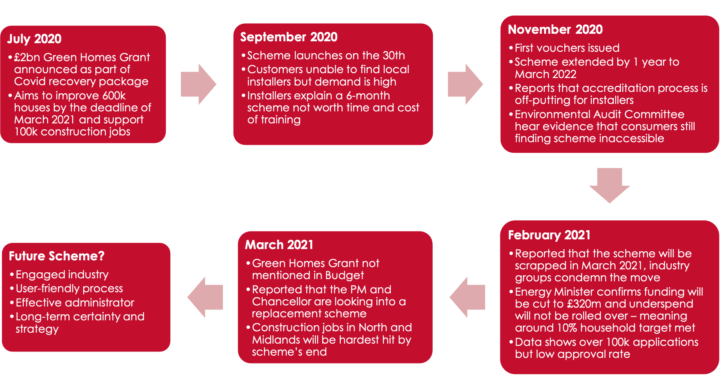Green Homes Grant: timeline and four lessons to be learned
What can the Government take away from the Green Homes Grant and apply to its successor, and what should it avoid?

By Jess Ralston
@jessralston2Share
Last updated:
The rollercoaster that is the Green Homes Grant took another turn in mid-March, with reports that it is to be scrapped and replaced by a whole new scheme bringing another twist to the seemingly never-ending ride.
The latest insights detail a back-and-forth between Treasury and Number 10 over the future, if any, for a widespread home improvement scheme. Rather than a post-mortem, there are clear lessons that can be learnt from the Green Homes Grant, ensuring that a replacement is implemented and that it is a success.
Demanding
Climate change is now one of the British public’s top concerns. This can be seen directly feeding through into actions taken in domestic life; signing up to green energy tariffs, cutting down on food with high carbon footprints, and crucially, taking an interest in plugging our leaky homes.
The answer to a recent Parliamentary question showed more than 110,000 applications for upgrades under the Green Homes Grant scheme. In normal times this figure would be impressive, it is even more so mid-pandemic and mid-home schooling.
Interest into bettering homes seems to have sky-rocketed during the course of 2020 with three in five homeowners carrying out renovation projects during lockdown.
It’s not just a desire to cut carbon; more time at home means higher energy bills. ECIU analysis last year found that spending all winter in the home would see heating use jump by more than 50%, pushing up bills with it. Announcing a scheme with promises of cutting up to £600 from bills clearly resonated, hence polling showing interest from up to 13.2 million households.
Public confidence is hard to gain and easy to lose. Experts such as the HomeOwners Alliance have voiced concerns over pulling the scheme, while the all-too-frequent comparisons to the failed Green Deal highlights the risks of policy failures.
Ultimately, the Government has a target to upgrade homes, one that will need amending to get on track to net zero. Failing to bring in demand-led schemes runs the risk of politically unpalatable ideas such as minimum sale standards being relied on. A speedily implemented replacement to capture this demand is a clear first step.

Strong and stable
A long-term plan for decarbonising the nation’s 19 million homes has been a long time coming. The Treasury’s hasty jump in and pull back from efficiency policy only highlights the benefits of longer-term thinking.
As Tory strategists start to look towards a second term, it is ever clearer that something needs to be done about homes – one of the largest holes in current national decarbonisation efforts won’t fly in 2028 or 2029, especially with soon-to-be-updated efficiency targets.
The rushed nature of the Green Homes Grant meant that there was an assumed expectation that it could tap into a workforce that wasn’t ready. Scarred by past experiences, a lack of support for energy efficiency and unable to justify the expensive training costs, the workforce was thrown into the deep end and failed to swim.
To achieve the Green Homes Grant’s aims, long-term clarity over energy efficiency standards, stable funding commitments and effective delivery methods will go a long way. After all, security of investment and a self-sustaining market not reliant on boom-and-bust subsidy cycles – any Conservative Government’s ultimate aim – are the product of well-thought-out and stable policy environments.
Jobs, jobs, jobs
Branded as ‘reckless’, the hasty start date for the Green Homes Grant left just two months for installers to gain the necessary accreditation before the scheme went live. In addition, the six-month expiry date left the majority feeling there was no point in investing.
Unfortunately for Government, a tentative step forwards with a year’s extension to the scheme did little to quench industry fears as just one in six households were able to find local firms where they could cash in their voucher. Even now, under 1,000 installers have ‘active’ registration, or less than 1 per 110 households that applied.
The lesson here is that properly communicating with the industry that is delivering the scheme is paramount. Without installers to carry out the works, it won’t get done. The PR that accompanied the launch of the Green Homes Grant anticipated the creation of 100,000 jobs, working with industry is essential in delivering these.
Outsourced
For some reason, tried and tested methods of delivery – such as the energy supplier-led Energy Company Obligation – were bypassed in the majority of Green Homes Grant, favouring an American administrator, ICF to handle the homeowner voucher side of the scheme.
Reports of uncontactable customer service, slow application reviews and most worrying of all, a complete lack of payments sent to installers for work completed have tarnished the reputation of the scheme as a whole.
With growing levels of dissatisfaction inside and outside of Government on how ICF has handled the scheme, there’s no doubt that steps taken to nullify these issues in the subsequent scheme will be a priority for the Government.
Next up
The Heat and Buildings Strategy is now expected in May. For optimists, this gives time for Government to reflect on mistakes and pull together an effective programme.
‘You either pay for it now, or pay for it later’ were the words from the CBI’s head of climate change. For a Prime Minister feeling the heat on climate actions and a Treasury looking to liberate lockdown savings from millions of households, a rebooted home upgrades scheme could be just the ticket.
Share